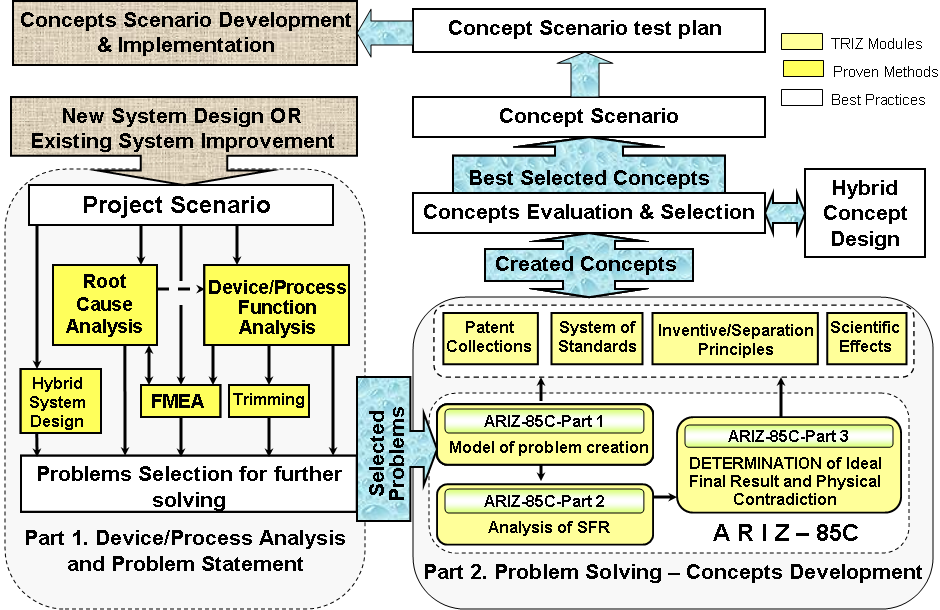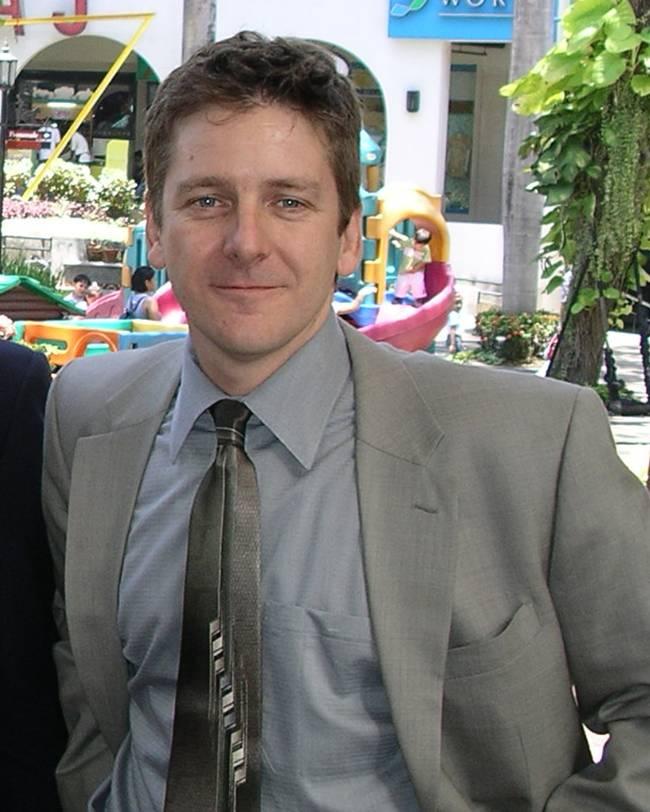Stop learning to innovate through trial and error
Learn TRIZ, a methodology developed by Genrick Altshuller for solving problems more efficiently and intuitively.
We will talk about HOW to use all modules of TRIZ as a complete and harmonic system in combination with other proven methods in the most effective way. TRIZ – Technology for Innovation is represented by TRIZ Innovation Roadmaps for Projects Creation & Problem Solving
We included in TRIZ Innovation Roadmap together with TRIZ modules other proven methods in order to create a complete (almost complete) set of tools for the Conceptual stage of Product/Process design (Fig. 1):
- Value Analysis & Value Engineering
- Root-cause analysis - RCA
- Failure Modes and Effects Analysis – FMEA
- Hybrid (alternative) system design
- Trimming
- Hybrid Concept Design
- Concept Scenario

About the Author:

Vice President of Altshuller Institute for TRIZ Studies.
Isak is a TRIZ, Value Methodology (VM), and Six Sigma specialist with more then 35-year practice in the product/process development and manufacturing areas. Isak has spent 7 years at IMC (Invention Machine Corporation) as their chief methodology specialist and now works as independent global consultant (owner of TRIZ Solutions, LLC ). During the last six years he guided development of 78 innovation projects in 11 countries for 39 world leading companies such as Philips, Mattel/Fisher-Price, Microsoft, Shell, Samsung, POSCO, Masco-Behr, Medtronic, Xinetics, Henkel, Delphi, Baker Hughes, J&J, BaoSteel, NXP, Intel, Savannah River Site, etc.
Isak has delivered numerous basic and advanced training seminars (some of them together with Mr.Genrich Altshuller), and educated and trained thousands of Managers, Engineers, and Researchers in TRIZ/Value Methodology, and in Product/Process Evolution and Development.
In 80's Isak dedicated about 7 years for children/juniors education of creativity (TRIZ) in his native country Latvia.
Tel: (617) 926-7145; cell: (617) 218-7415; Skype id: bukhman
This email address is being protected from spambots. You need JavaScript enabled to view it. www.TRIZSolution.com
- Details
- Category: Abstracts
Value Management is a function based methodology focused on improving value (defined as function ÷ cost). Its function-based analysis, and traditional brainstorming approach to problem solving, share a number of characteristics with TRIZ, creating a unique opportunity to apply TRIZ principles into the Value Methodology. The synergy between these approaches results in enhanced brainstorming output (quantity of high quality ideas). This paper will examine ways to integrate key ingredients of these two approaches and the benefits that can be realized from the combination of the Value Methodology and Structured Innovation.
 John Borza, President, Value Innovation, LLC, has been involved in creativity and innovation as an Engineer and Manager for over 30 years, concentrating the past several years in the area of Value Engineering and TRIZ. Mr. Borza earned a BS degree in Electrical Engineering and an MBA from the University of Michigan. He is an accomplished facilitator and trainer who has successfully led numerous workshops in a variety of automotive product areas, resulting in significant cost reductions, improved products, and patentable innovations, and has trained hundreds of Engineers and Managers in Structured Innovation techniques. He is a Registered Engineer, an AI certified TRIZ Practitioner, and holds an Associate Value Specialist certification from SAVE International. He is also the President of the Greater Michigan Chapter of SAVE International, and a member of SAE (Society of Automotive Engineers).
John Borza, President, Value Innovation, LLC, has been involved in creativity and innovation as an Engineer and Manager for over 30 years, concentrating the past several years in the area of Value Engineering and TRIZ. Mr. Borza earned a BS degree in Electrical Engineering and an MBA from the University of Michigan. He is an accomplished facilitator and trainer who has successfully led numerous workshops in a variety of automotive product areas, resulting in significant cost reductions, improved products, and patentable innovations, and has trained hundreds of Engineers and Managers in Structured Innovation techniques. He is a Registered Engineer, an AI certified TRIZ Practitioner, and holds an Associate Value Specialist certification from SAVE International. He is also the President of the Greater Michigan Chapter of SAVE International, and a member of SAE (Society of Automotive Engineers).
- Details
- Category: Abstracts
Perception Mapping and Contradiction Resolution of Voice of the Customer (VOC)
Problem Solving Custom Methodology Case Study
David W. Conley, Innomation, LLC
This work presents a case study for a portion of a business process improvement systematic innovation analysis completed at Presbyterian Health Services of New Mexico. Manifold techniques and methodologies are demonstrated which could be useful to anyone pursuing innovation work. The reader will be given insight to: what aspects of an innovation analysis correlate with what portions of the problem definition, problem abstraction, solution abstraction and specific solution development cycle, using Voice of the Customer as input to problem models, building and scoring a Perception Map, distilling contradictions from Voice of the Customer statements, assigning improving and worsening parameter categories based on Perception Map scores, using the 40 Principles to solve contradictions, using measurement criteria to sort solution concepts into short, medium and long-term groupings, using Critical to Quality statements to predict the effectiveness of solution concepts, and the general merger of multiple problem solving methodologies into a single solution engine.
 Biography: David Conley received his BS of Nuclear Engineering from Texas A&M University and his Masters of Finance from the University of New Mexico. As an Air Force Officer he performed plasma physics and space nuclear propulsion research and served at Los Alamos and Brookhaven National Laboratories and on NASA’s Nuclear Safety Review Panel. His private sector experience includes Johnson and Johnson, Philips Semiconductor and Intel Corporation. At Intel since 1995 David has held a variety of engineering and management roles and is currently Intel’s only Level 4 TRIZ Specialist worldwide. Certified by the St. Petersburg school of the International TRIZ Association, David’s contributions to the field of systematic innovation include: technical and business problem solving, training material development, methodology training, program integration and serving on the Executive Board of the US based Altshuller Institute for TRIZ Studies. David has broad international business and engineering experience and currently lives in New Mexico, USA with his wife and three sons.
Biography: David Conley received his BS of Nuclear Engineering from Texas A&M University and his Masters of Finance from the University of New Mexico. As an Air Force Officer he performed plasma physics and space nuclear propulsion research and served at Los Alamos and Brookhaven National Laboratories and on NASA’s Nuclear Safety Review Panel. His private sector experience includes Johnson and Johnson, Philips Semiconductor and Intel Corporation. At Intel since 1995 David has held a variety of engineering and management roles and is currently Intel’s only Level 4 TRIZ Specialist worldwide. Certified by the St. Petersburg school of the International TRIZ Association, David’s contributions to the field of systematic innovation include: technical and business problem solving, training material development, methodology training, program integration and serving on the Executive Board of the US based Altshuller Institute for TRIZ Studies. David has broad international business and engineering experience and currently lives in New Mexico, USA with his wife and three sons.
- Details
- Category: Abstracts
- Details
- Category: Abstracts
Read more: TRIZ in a Bi-system, Consisting of TRIZ and Lean Sigma

One of the oft encountered problems while applying TRIZ to real world problems is to identify from a large set of promising solution directions, the ones that are most promising, elegant or closest to ideality. This is especially true when the problem can be defined at multiple system levels, each level having multiple paths flowing towards the ideal final result. This paper describes such a situation encountered while analyzing a real world problem (rebar tying) with TRIZ. Steel reinforcement bars are tied together to form grids and reinforce concrete. Rebar tying machines have evolved over the years from pneumatic and mechanical systems to electro-mechanical systems with embedded electronics. TRIZ-based analysis and ideation resulted in a large number of interesting evolution paths for the rebar tying system. However, the question “Which paths would evolution favor” was difficult to answer. TRIZ does offer clues to pre-select the most promising paths in advance, but needs an integrated approach for the same. The paper describes such an integrated approach with the rebar tying case study as reference.
- Details
- Category: Abstracts
Read more: Choosing the most promising system evolution paths with TRIZ - Rebar Tying Case Study

Now automobile is a very popular product in human live, and so many people depended on it for work, life. The automobile steering wheel system was an important part for driving the automobile, especially for guiding it and supplying the safety for the driver. Up to now the steering wheel system had been past more than hundreds years and its riding comfort, safety, manipulation, function, material, human vision, and high tech application had been developed or evolved in many aspects continuously. The steering wheel system passed through a process of birth, growth, maturity, death and quit the stage like biological evolution process. And now which stage in the whole life of the steering wheel was confirmed is crucial for the company to draw up the strategy for the future development.
Therefore the research on forecasting analysis of the automobile steering wheel had been done, and this paper included the forecasting analysis on the technological maturity based on TRIZ, putting forward some new ideas about future automobile steering wheel system.
Keywords: forecasting analysis, technological evolution, steering wheel system, technological maturity.
- Details
- Category: Abstracts
Read more: Forecasting Analysis of the Maturity of Automobile Steering Wheel System on TRIZ

One of the things that makes TRIZ so powerful is that it has grown to encapsulate a high level philosophical view of the world. In this regard, TRIZ is not unique. This paper will examine two other meta-level worldviews in order to explore some of their similarities and differences with TRIZ. The first of the two is the ‘Metaphysics of Quality’ originated by best-selling author of ‘Zen and the Art of Motorcycle Maintenance’ and ‘Lila: An Inquiry Into Morals’ Robert M Pirsig; the second is the (currently rather less well known) Fundamental Design Method (FDM) developed over the course of a forty period from the 1950s to the 1990s by Edward Matchett.
In describing Pirsig’s concept of Dynamic Quality and Matchett’s ‘5M’ equation and the concept of ‘Making Media plus Matter Meaningful in the Moment’, the paper suggests that even though neither appears at first glance to be compatible with high-level TRIZ concepts like Ideality, Contradiction and System Completeness, it is in fact possible to construct a model consistent with and containing all three.
Of particular interest to the TRIZ community, the paper sets out to detail this new model. In so doing highlight important concepts and ideas that are not presently found within the TRIZ framework are revealed that should enable considerable enhancement to the way TRIZ should be viewed and, more importantly, used.
- Details
- Category: Abstracts
Read more: Collateral Beauty: Integrating TRIZ, Fundamental Design Method & Metaphysics of Quality
Abstract: Cause-Effect Analysis and Resource Analysis is not only important for modern TRIZ, but also the key step for problem-solving. This paper introduces a method to conduct Cause-Effect Analysis and Resource Analysis as an integral part and integrate the former with other Cause-Effect Analysis methods, which has been used in many engineering problems and is effective and efficient for many engineers. In this paper, both its rationale and its detailed steps are described, and at the final part there is a case study for a real problem. By the way, it is easy to implement this method in software, thus it will be better for the users to solve engineering problems, of course the above case is made in such a software.
- Details
- Category: Abstracts

Theory of Inventive Problem Solving (TRIZ, pronounced as treez) provides a powerful mechanism to strengthen the thinking skills of the practitioner.
Over successive decades TRIZ has matured to provide a robust platform for practitioners to generate elegant solutions to problems, predict potential failure points, direct the evolution of products and manage intellectual property. TRIZ concepts have been demonstrated equally effective for skilling kids.
Yet after years of existence and ample case studies the vast sea of humanity seems to be indifferent to the existence of TRIZ.
Could it be part of a bigger conspiracy to keep TRIZ a secret similar to what is alleged to have been done for the aliens that visit planet earth or is it that the TRIZ’niks employ a language that masses cannot relate to?
The TRIZ community is encountering multiple contradictions in its journey of evolution.
For example, if we make the language simple then the man on the street will understand but it will dilute the power of the methodology and vice versa.
Can we apply the principles of TRIZ to resolve the underlying contradictions to make the concepts of TRIZ a universally adopted practice?
- Details
- Category: Abstracts

Authors: Ellen Domb, Joe Miller ans Ralph Czerepinski
Learning TRIZ is a function, and the student and teacher are a “technical system” that can be analyzed using TRIZ, and improved by applying the analysis. Extensive research on education (reported at TRIZCON2009) has been applied to TRIZ, to develop training mechanisms that are appropriate for the specific concepts, and adaptable to the students’ learning styles. One universal finding, for all the teaching mechanisms, is that learning takes place when the student applies the new concept to his own situation, but that many students never make that step because of fear—the consequences of being wrong outweigh the benefits of learning. Applying the TRIZ principles of using existing resources and of adding an intermediary , community resources such as museums and amusement parks can become an important part of the learning method, giving the student a safe environment, with easily understood technologies, to practice the application of classroom learning and prepare for on-the-job application. The method will be demonstrated with case study examples.
- Details
- Category: Abstracts
Read more: Teaching TRIZ: Leaving the classroom to enhance learning

- Details
- Category: Abstracts
Read more: 40 Principles and Contradictions in Human Factors and Ergonomics








